I am typing this at 30,000 feet above the Tasman Sea; heading towards Sydney, en route to Singapore, which is another 8 hours away. I left Christchurch, New Zealand, two hours earlier with my patient. She is comfortable, with oxygen delivered via a portable oxygen concentrator, and her vital signs are stable.
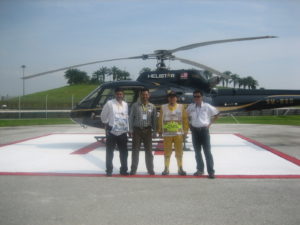
4 founding members of SAMM
I reflected on the experience of the patient’s son, who is accompanying us on this flight. When his mother developed medical problems while on holiday, he frantically looked for ways to bring her home, asking his contacts if they knew who might be able to help. A friend mentioned an article he read some time ago about the Society of Aeromedicine, Malaysia (SAMM) and that it could be worthwhile to ask if they could lend a hand. Despite searching the internet, the patient’s son could not find any details about SAMM. It was only through doctors who have worked with SAMM that he managed to get in touch with us.
Perhaps this is an opportunity for us to share about our services that could ultimately help you, or someone you know, one day.
—–
Here is a little background to how this all started. I started my housemanship training in Sabah in 1998. Back then, specialties like neurosurgery, vascular surgery and cardiothoracic surgery were not available in Kota Kinabalu. We often had to transfer patients on commercial flights to Kuala Lumpur for subsequent management. Those were the days when aeromedicine was almost unheard of in Malaysia and airport security was less strict than it is now. We brought blood and oxygen cylinders on board and the security personnel never gave us a second look.
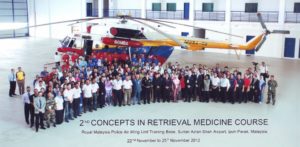
2nd aviation course
It was only in 2003 that I formally trained to perform transportation of critically ill patients. I signed up as an ad-hoc medical escort doctor with a private medical assistance company while pursuing post-graduate training in Anaesthesiology and Critical Care Medicine. Incidentally, the first case I did was with Col Dato’ Dr Jaseemuddeen Abu Bakar who, about 8 years later, became one of the founding members of SAMM and currently serves as its treasurer. That first mission led to many different adventures for us as we frequently worked on cases together.
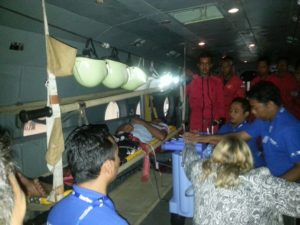
Complex IABP transfer
In 2008, I took a gamble by quitting my fellowship training in Cardiothoracic Anaesthesiology and pursued a completely different line of work in the corporate sector. I took on the role as Regional Medical Director for one of the top insurance companies in the world, a position I held until 2011.
I was exposed to the travel insurance industry during that time and noticed a gap in patient care for those whose policies were declined due to pre-existing conditions or other general exclusions. At the same time, most do not have the means to afford the expensive cost of patient transport. They were usually left to figure out how to get home by themselves. There was very little anyone could do to help.
The idea of an organisation to assist these cases came about around that time. We considered the availability of like-minded individuals who can offer their time and expertise to help patients with these specific needs.
I resigned from my job in 2011 and spent the next 6 months setting up the Society of Aeromedicine, Malaysia. Forming a society was easy but funding it was a challenge. Recognising this, 4 founding members decided to sign up as lifetime members and with the money from our membership fees, we began to recruit members. Groups of interest were Royal Malaysian Air Force (RMAF) personnel with an inclination towards Aviation Medicine, as well as Emergency Medicine and Anaesthesiology doctors heavily involved in critical care transportation.
Thankfully, we also had good friends in Australia. They helped write a proposal to the Department of Foreign Affairs and Trade (DFAT) of Australia, securing a grant to fly a team of 6 doctors and nurses from Careflight Sydney to organise the inaugural Concepts in Pre-Hospital Care and Transport course in Malaysia. From an initial group of 30, we managed to train 200 medical personnel in Ipoh with another grant the following year. For the third year running, we secured a grant from DFAT Australia; this time to fly some of our doctors over the Australia to present some papers.
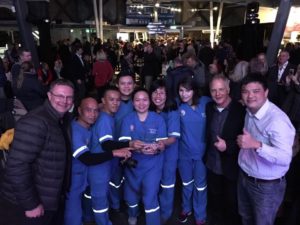
Sabah team with the winners trophy
After that, we mainly self-funded our activities and sent teams to Melbourne, Darwin and Queenstown to participate in the Australasian meetings. The meeting in Queenstown, New Zealand, (2016) was a proud moment for us – our team from Sabah won first place in the Aeromedical Stimulation Competition, beating out more experienced teams from Australia in New Zealand. What made it even more remarkable was the fact that the team was only in service since 2011.
We have also gained international recognition, establishing Malaysia as one of the founding members of the International Societies of Air Medical Services together with similar organisations from the United States of America, Europe, Australia and New Zealand. It was a big step for small fry like us, but we proved we could stand with the giants. In fact, at the end of August 2017, we flew to Sydney to attend the Australasian Aeromedical Conference for the sixth year running and signed fresh Memorandums of Understanding with our international friends.
As of today, SAMM has more than 50 members from various backgrounds, helping to achieve the objectives of the society.
—
After all that, you must be wondering: how is all this relevant to Malaysians?
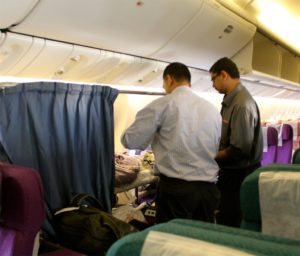
Setting up a patient on a stretcher
In spite of our underwhelming online presence, we regularly receive requests to help patients stranded in hospitals overseas. In the last 5 years, we have assisted an average of three patients a year, without any extra charges. The cost borne by family members is only the cost of transfer, which is usually a third of what needs to be paid if done privately.
We also secure a life insurance policy for our members, which covers any medical expenses incurred while transporting patients or, in the worst-case scenario, monetary compensation for any loss of life or limb. This is necessary because we are exposed to unique risks when we move patients in planes and helicopters, in addition to road ambulances.
That is who we are – the Society of Aeromedicine, Malaysia.I hope this information was helpful. If you ever come across anyone that may need our help, you can reach me via email at gunalan73@yahoo.com
Dr Gunalan is the Vice President SAMM and Consultant Anaesthesiologist and a Critical Care Physician.
[This article belongs to The Malaysian Medical Gazette. Any republication (online or offline) without written permission from The Malaysian Medical Gazette is prohibited.]
